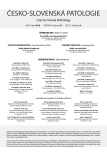Post mortem investigation of alveolar air in forensic practice
Authors:
Miroslav Bauer 1; Jiřina Bauerová 1; Ján Šikuta 2; Jozef Šidlo 3
Authors‘ workplace:
Ústav súdneho lekárstva, Lekárska fakulta, Slovenská zdravotnícka univerzita, Bratislava
1; Súdnolekárske pracovisko, Úrad pre dohľad nad zdravotnou starostlivosťou, Bratislava
2; Ústav súdneho lekárstva, Lekárska fakulta, Univerzita Komenského, Bratislava
3
Published in:
Soud Lék., 61, 2016, No. 4, p. 44-49
Category:
Original Article
Overview
Exhaled air from biological materials is used for the purpose of toxicologico-chemical analysis particularly in detecting of alcohol influence in traffic or within a working process. Similarly, still a more and more actual requirement seems to be a necessity to analyse alveolar air from necroptic material. This necessity is emphasised not only by the fact, that inhalant intoxications in the form of poisoning represent their substantial part, but also a demand to evidence exactly a noxious agent both specifically and also in at least two materials. And particularly this is sometimes a subject to search for evidence in alveolar air. The authors present their author’s certificates for Isolation of alveolar air from autopsy material, issued by the Office for Patents and Inventions in Prague, verified in practice, both by destruction of lung tissue, both the evacuation of alveolar air into a defined volume, hermetically closed space that is used for the toxicological analysis of gaseous and volatile xenobiotics. They propose experimentally verified procedures and conditions obtained by time-consuming examination. To isolation procedures were subjected an adequate number of lung lobes from lungs removed in 201 autopsy cases. The authors practically tested the presupposed amount of alveolar air in individuals according to gender and age. Gradually they have validated various prototypes and optimization methods and their application in solving particular inhaled lethal intoxications and deaths in the irrespirable environment.
Keywords:
autopsy material – alveolar air – the evacuation of the alveolar air – lung destruction – toxicological analysis
Sources
1. Šidlo J, Bauer M, Bauerová J, Valuch J. Diagnostics of fatal hydrogen sulfide poisonings. Soud Lek 2009; 54(3): 37-40.
2. Borovanský L. Soustavná anatomie člověka, díl II. Praha: Státní zdravotnické nakladatelství; 1967: 490.
3. Autorské osvědčení číslo 171795 Úřadu pro vynálezy a objevy v Praze, přihláška vynálezu PV 8113-72, Praha, 28. června 1978.
4. Autorské osvědčení číslo 172517 Úřadu pro vynálezy a objevy v Praze, přihláška vynálezu PV 1295-73, Praha 6. července 1978.
5. Kolektiv. Dětské lékařství. Praha: Státní zdravotnické nakladatelství; 1964: 299.
6. Bauer M. Isolierung der Luft aus der Lunge der Leiche für die toxikologish-chemische Analyse. Z Rechtsmed 1973; 73: 115-118.
7. Valent D, Šidlo J, Kuruc R, Očko P, Mlynár J. Analysis of fatal cases due to asphyxia and gas inhalation in a confined space. Fol Soc Med Leg Slov 2012; 2(2): 141-146.
Labels
Anatomical pathology Forensic medical examiner ToxicologyArticle was published in
Forensic Medicine

2016 Issue 4
Most read in this issue
- Post mortem investigation of alveolar air in forensic practice
- Two autopsy cases in which previous surgery facilitated the positive identification of decomposed bodies
